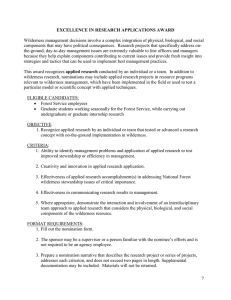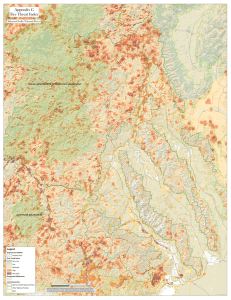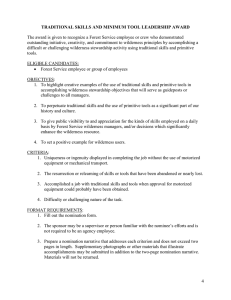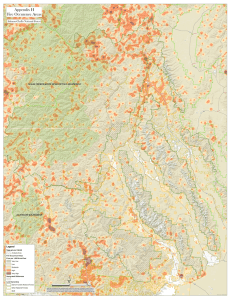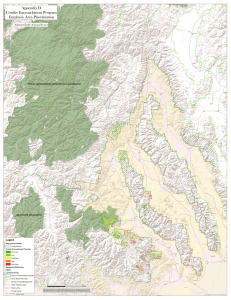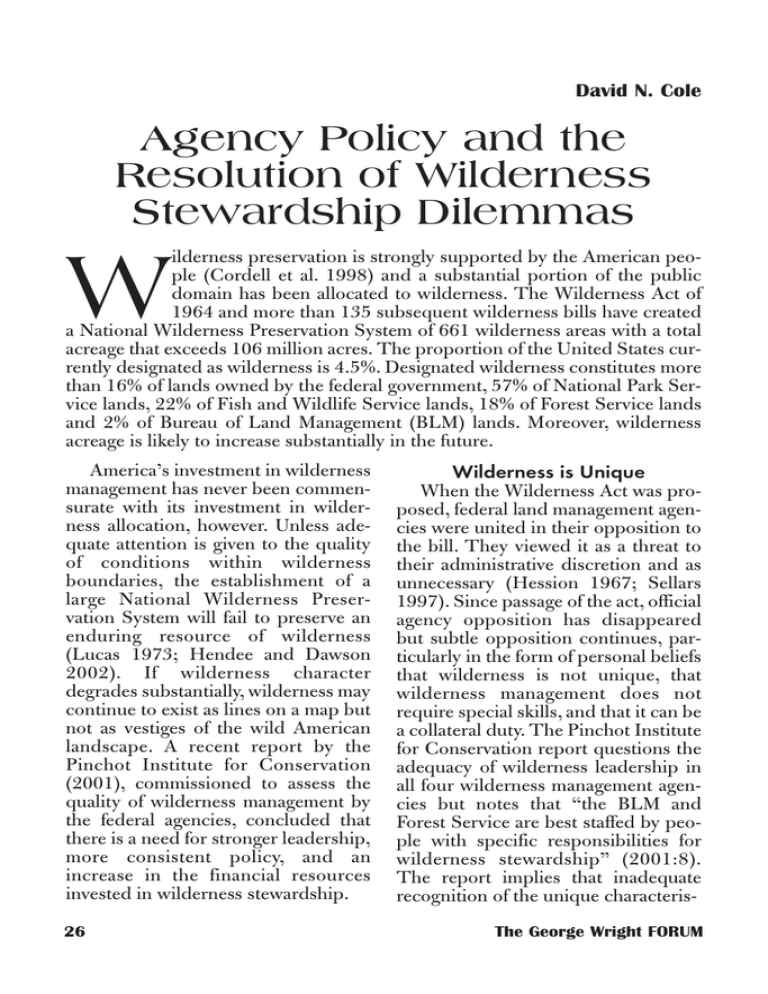
David N. Cole
Agency Policy and the
Resolution of Wilderness
Stewardship Dilemmas
ilderness preservation is strongly supported by the American people (Cordell et al. 1998) and a substantial portion of the public
domain has been allocated to wilderness. The Wilderness Act of
1964 and more than 135 subsequent wilderness bills have created
a National Wilderness Preservation System of 661 wilderness areas with a total
acreage that exceeds 106 million acres. The proportion of the United States currently designated as wilderness is 4.5%. Designated wilderness constitutes more
than 16% of lands owned by the federal government, 57% of National Park Service lands, 22% of Fish and Wildlife Service lands, 18% of Forest Service lands
and 2% of Bureau of Land Management (BLM) lands. Moreover, wilderness
acreage is likely to increase substantially in the future.
W
America’s investment in wilderness
management has never been commensurate with its investment in wilderness allocation, however. Unless adequate attention is given to the quality
of conditions within wilderness
boundaries, the establishment of a
large National Wilderness Preservation System will fail to preserve an
enduring resource of wilderness
(Lucas 1973; Hendee and Dawson
2002). If wilderness character
degrades substantially, wilderness may
continue to exist as lines on a map but
not as vestiges of the wild American
landscape. A recent report by the
Pinchot Institute for Conservation
(2001), commissioned to assess the
quality of wilderness management by
the federal agencies, concluded that
there is a need for stronger leadership,
more consistent policy, and an
increase in the financial resources
invested in wilderness stewardship.
26
Wilderness is Unique
When the Wilderness Act was proposed, federal land management agencies were united in their opposition to
the bill. They viewed it as a threat to
their administrative discretion and as
unnecessary (Hession 1967; Sellars
1997). Since passage of the act, official
agency opposition has disappeared
but subtle opposition continues, particularly in the form of personal beliefs
that wilderness is not unique, that
wilderness management does not
require special skills, and that it can be
a collateral duty. The Pinchot Institute
for Conservation report questions the
adequacy of wilderness leadership in
all four wilderness management agencies but notes that “the BLM and
Forest Service are best staffed by people with specific responsibilities for
wilderness stewardship” (2001:8).
The report implies that inadequate
recognition of the unique characterisThe George Wright FORUM
tics and challenges of wilderness is
most problematic in the National Park
Service and Fish and Wildlife Service,
where it is not uncommon to hear
leaders argue that wilderness is no different from park backcountry or that
wilderness designation should not
influence refuge management objectives. Sellars (1997:191) notes the
prevalence of the belief that wilderness
designation is “redundant” within the
National Park Service leadership.
Such beliefs are barriers to effective
wilderness stewardship and reflect a
poor appreciation for wilderness values and the support of the American
people for those values.
Wilderness Stewardship is
Challenging and Requires
Financial Resources
Funding for wilderness management is meager in all four management
agencies. For example, the Forest
Service spends less than 1% of its
annual allocation of about $4 billion
on wilderness management, despite
the fact that 18% of Forest Service
lands are designated wilderness.
Investment in wilderness science is
even more anemic. The Forest Service
provides the vast majority of funding
devoted to developing a scientific
basis for wilderness management, and
yet Forest Service research invests less
than 0.5% of its annual budget on
wilderness management science. The
other agencies invest considerably
less.
Inadequate funding might be
explained by a perception that wilderness management is a simple business.
Nothing could be further from the
truth, however. Management of
Volume 20 • Number 3
wilderness requires as diverse an array
of information and skills as any land
management job (Cole 1990).
Wilderness managers must maintain
ecological conditions and processes,
as well as provide outstanding opportunities for solitude and primitive
recreation. They must develop a good
understanding of the conditions and
processes that make up the wilderness
resource—air and water quality,
wildlife, recreation, and much more.
They need to develop quantifiable
objectives for the conditions wilderness is to provide, monitor these conditions to see if objectives are being
met, and develop and implement management strategies and action plans for
dealing with situations where objectives are not being met. Moreover,
management challenges are exacerbated by the remoteness of many wilderness lands, the scale and complexity of
the systems involved, provisions for
nonconforming uses, conflict between
competing goals and, particularly, by
the need to manage with a light hand
(Pinchot Institute for Conservation
2001).
Wilderness
Management Dilemmas
Inadequate funding and limited
recognition of what distinguishes
wilderness from other land classifications are two obvious problems resulting from “a lack of official attention to
sound wilderness stewardship”
(Pinchot Institute for Conservation
2001:4). Lack of attention by agency
leadership also has resulted in confusion regarding how to resolve several
fundamental dilemmas of wilderness
stewardship. This is particularly true
2003
27
of two dilemmas that face wilderness
managers.
The first of these involves the conflict between providing access to
wilderness for its “use and enjoyment”
and protecting the biophysical conditions and visitor experiences that are
unique to wilderness but can be
degraded by recreational use.
Recreation use of wilderness continues to increase (Cole 1996a) and
Congress exacerbates this problem by
designating heavily used lands adjacent to metropolitan areas as wilderness. How do we balance the needs of
society for periodic escape from hectic
lifestyles to places of personal renewal
with the mandate to protect wilderness conditions from degradation? In
National Park Service wilderness, this
is mostly a day-use issue. Overnight
visitation is usually limited, while dayuse goes unmanaged and usually
unmonitored. Hundreds of people per
day hike popular wilderness trails in
parks such as Yosemite and
Shenandoah, seeking respite from the
crowded city and reunion with nature.
Should this be allowed or should most
day visitors be turned away? Such a
question is even more difficult to
answer for a wilderness such as Pusch
Ridge, with boundaries immediately
adjacent to suburban backyards in
Tucson, Arizona. Should we allow
heavy use in some places or in some
wilderness areas but not in others?
The second dilemma concerns the
appropriateness of manipulative
restoration in wilderness. This dilemma is subtle and has only recently
come to light (Graber 1995; Cole
1996b). Ideally, wilderness is a place
where natural conditions and process28
es are preserved, where conditions are
little different from what they would
have been in the absence of post-aboriginal humans. Wilderness is also to
be “untrammeled,” which means not
controlled or intentionally manipulated by modern humans. I have referred
to this attribute as “wildness” (Cole
2000, 2001). At one time, hands-off
management was sufficient to keep
wilderness both natural and wild. As
the human imprint on the globe
increases and is better understood,
however, it is clear that wilderness
conditions have been altered by such
human agents as global warming, invasions of exotic species, and fire suppression. For example, whitebark pine
forests in the Rocky Mountains are
being decimated by an exotic
pathogen (white pine blister rust).
This threatens grizzly bear populations that are dependent on whitebark
pine seeds for a significant proportion
of their diet (Tomback et al. 2000).
Should we breed rust-resistant whitebark pines and plant them in wilderness to protect natural ecosystems and
grizzly bears or is manipulation of
genes and populations unacceptable
in wilderness? To compensate for
anthropogenic impact, should we
intentionally manipulate wilderness
ecosystems in some cases but not in
others, or in some wildernesses but
not in others?
Reasons These Dilemmas Exist
The proximate reasons why these
dilemmas have never been resolved are
ambiguity in the language of the
Wilderness Act and insufficient policy
and direction from agency leadership.
Consequently, different wilderness
The George Wright FORUM
advocacy groups interpret the
Wilderness Act in different ways,
advancing those wilderness values
they hold most dear. Some groups
interpret the Wilderness Act as a mandate for not allowing heavy recreation
use anywhere in the National
Wilderness Preservation System and
for not manipulating wilderness
ecosystems even where there are pronounced human impacts. In contrast,
other groups believe it is inappropriate to restrict recreational access
where recreation use has traditionally
been heavy (except perhaps to avoid
excessive biophysical impacts). Other
groups believe it is appropriate to
manipulate wilderness ecosystems,
using prescribed fires or herbicides for
example, to compensate for human
impact and protect native ecosystems
and biodiversity.
The roots of these dilemmas can be
traced to the divergent purposes for
which wilderness has been designated. In Driven Wild, Sutter (2002)
offers new and enriched perspectives
on the motivations of some of the earliest and most influential wilderness
advocates. He makes a compelling
case that the primary motivations for
wilderness preservation originally had
more to do with keeping automobiles
and recreational developments out of
wilderness than with protecting
wilderness from too many people.
They also had more to do with primitiveness and the absence of human
control than with a concern for pristine ecological conditions. As Howard
Zahniser (1963), the primary author
of the Wilderness Act, famously said,
stewards of wilderness should be
“guardians not gardeners.” This conVolume 20 • Number 3
trasts profoundly with the more recent
opinion of ecologist Dan Janzen
(1998) that the “gardenification” of
wilderness is necessary and desirable.
The primacy of these motivations
did not result from ecological ignorance or inadequate appreciation of
the value of ecological preservation;
rather they reflected the fact that the
Ecological Society of America was
working simultaneously to establish a
representative system of areas protected in their natural condition. Sutter
quotes a letter written in 1940 by Aldo
Leopold, which states that “the
[Wilderness] Society ... is mainly
interested in wilderness recreation.
Another group, the Ecological
Society, is interested in wilderness
study” (2002:280).
While the stream of thinking that
led directly to the language and passage of the Wilderness Act was
focused on primitive recreation in
large undeveloped areas that were to
be “untrammeled,” these same people
recognized the value of other types of
land preservation. In 1932, Bob
Marshall wrote the recreation sections
of a congressionally commissioned
report on the nation’s forests (U.S.
Congress—Senate 1933). He recommended the preservation of seven
types of recreational areas, including
both “wilderness areas” (which would
emphasize primitive recreation) and
“primeval areas” (which would provide representative examples of
ecosystems in their natural state).
Sutter describes the initial (1935) platform of the Wilderness Society, which
identified the need for five “Types of
Wilderness” (2002:246–247). Three
of these types seem relevant to the
2003
29
stewardship dilemmas we face today.
“Extensive Wilderness Areas” were to
be large areas free from mechanization, devoted to primitive recreation
and with substantial symbolic value as
reflections of human humility and
restraint. “Primeval Areas” were to be
tracts preserved in their natural state
for scientific and aesthetic values, and
“Restricted Wild Areas” were to be
free from the sights and sounds of
mechanization and near concentrated
areas of population. The founders of
the Wilderness Society recognized the
need to preserve wilderness for at least
three somewhat divergent purposes:
primitive recreation in wild landscapes with symbolic value (their primary interest), preservation of natural
ecosystems, and recreational escape
from the city. Moreover, they recommended that lands devoted to these
purposes be designated as different
types of wilderness.
The management dilemmas we face
today result primarily from Congress
ignoring this recommendation.
Regardless of the purpose of designation, areas are simply referred to as
“wilderness” and are managed according to the language of the Wilderness
Act, language that came largely from
the tradition of the extensive wilderness area, where the primary motivations were primitive recreation and
freedom from modernization and
human manipulation. No similar landmanagement system has been developed to adequately provide the benefits of a system of natural ecosystems
or of scenic, natural-appearing lands
accessible to urban populations. The
access vs. preservation dilemma
results from Congress designating as
30
wilderness both lands valued because
they are large, uncrowded, and primitive and lands valued because they are
primitive but provide easy access to
city-dwellers. The naturalness vs.
wildness dilemma results from
Congress designating as wilderness
both lands valued because they are
free from human control and lands valued because they are representative of
natural ecosystems.
Policy Needs to be Developed
In seeking resolutions to management dilemmas, the traditional
approach has been to consider the
merits of each situation on a case-bycase basis to arrive at an acceptable
compromise between competing
goals. Given the decentralized decision-making tradition of land management agencies, such decisions are typically made independently and repeatedly by mid-level officials, buffeted by
the polarized arguments of opposing
sides. In this environment, most decisions are likely to be made in similar
fashions everywhere, causing the
wilderness system to gravitate toward
homogeneity and mediocrity (Cole
2000, 2001).
At a recent wilderness science conference, Foreman (2000) used “The
River Wild” as a metaphor for the conservation movement. The movement
grows in power and diversity as individual tributaries join together in the
effort to preserve wilderness. Different
tributaries include the three purposes
for wilderness noted above—the interest in protecting opportunities for
extended primitive recreational trips,
the interest in preserving natural sanctuaries, and the interest in providing
The George Wright FORUM
places for crowded city-dwellers to
recreate in a primitive, undeveloped,
and largely natural environment. This
is an apt metaphor for demonstrating
that new streams (purposes and values
of wilderness preservation) do not
replace old streams. Each stream adds
to the overall power of the river, resulting in the large National Wilderness
Preservation System we have today.
The implication of this metaphor
that Foreman does not explore is what
happens when tributaries with divergent characteristics are joined, blending waters and diluting the original
purity of each tributary. The mixing of
divergent purposes within wildernesses muddies the waters, leading to loss
of many of the values wilderness designation was meant to preserve.
The primary recommendation of
the Pinchot Institute for Conservation
(2001) is that wilderness be managed
as a system. Most of the authors’
emphasis, however, is on integration
and collaboration between the four
wilderness management agencies.
Inadequate interagency collaboration
is a problem, but inconsistency
between agencies may actually promote diversity and enhance the value
of the wilderness system. Inadequate
policy and decentralized decisionmaking may be greater threats to the
preservation of quality within the
wilderness system. Policy is needed
that will maintain the purity of wilderness lands designated for divergent
purposes—to avoid the muddied
waters and loss of values that occurs
when competing wilderness purposes
are compromised on a case-by-case
basis. A regional and national perspective needs to be developed to help
Volume 20 • Number 3
stewards of individual wildernesses
make decisions about access and
preservation, about naturalness and
wildness. Only from this perspective is
it possible for local decisions to optimize rather than dilute the values of
the National Wilderness Preservation
System (McCool and Cole 2001).
The Policy of Non-degradation
Non-degradation provides an
example of how policy options could
be assessed and decisions could be
made that would have a profound
effect on the future benefits of our
wilderness system. Some argue that
the Wilderness Act mandates nondegradation of wilderness, that actions
must be taken to ensure that wilderness conditions (e.g. natural, wild
ecosystems and opportunities for solitude) not be allowed to degrade following wilderness designation (Worf
2001). Worf (2001) asserts that, within the Forest Service at least, nondegradation has always been official
policy. However, there are numerous
examples where research and monitoring have shown increases in biophysical impacts and in crowding in
Forest Service wilderness since designation (e.g., Cole 1993, 1996a). This
suggests that we in the Forest Service
are not currently managing wilderness
according to the principle of nondegradation. It also begs the question,
should we do so?
This is the question at the core of
the access vs. preservation dilemma. It
is my opinion that educational programs, such as Leave-No-Trace, and
other management actions have
already reduced per capita impact
almost as much as might be expected.
2003
31
If so, further increases in recreational
use will inevitably cause further degradation of wilderness. Therefore, if we
pursue a policy of non-degradation,
we must immediately limit recreation
use everywhere in the wilderness system (in fact, a strict interpretation
would require reductions in use across
the system). Our choices and their
implications are clear. In my opinion,
we need to use clarifying concepts
such as non-degradation to assess
costs and benefits and to debate the
merits of alternative policies. These
hard but decisive choices carry such
profound long-term implications that
they should be made at the highest
levels of the land-management agencies instead of being delegated to midlevel management.
Conclusion
The stewardship needed to preserve wilderness values in perpetuity
depends on increased recognition of
the uniqueness of wilderness and
increased commitment, attention,
leadership, and financial resources.
Given the uniqueness of wilderness
and the complexity of wilderness
stewardship, increased attention
needs to be given to wilderness sci-
ence, as well as wilderness management, particularly by agencies other
than the Forest Service. Equally
important is the clarification of polices
regarding the purposes of wilderness
designation. Currently, wilderness
stewards facing management dilemmas have little option other than to
compromise between divergent purposes and values. Compromise is the
best way to optimize the value of an
individual wilderness. However, compromise does not optimize the value of
the National Wilderness Preservation
System. Ironically, to preserve divergent values within the system, individual managers should choose between
competing values. The need I envision
is for a referendum on the legitimate
purposes and values of designated
wilderness. Then wilderness management agencies must cooperate and
develop the institutional capacity to
preserve wilderness values in perpetuity. To the degree that legitimate
wilderness values conflict, cooperation and institutional capacity has less
to do with making consistent decisions and more to do with planning to
preserve the purity of varied streams
of wilderness purpose.
References
Cole, D. N. 1990. Wilderness management: has it come of age? Journal of Soil and Water Conservation 45,
360–364.
———. 1993. Campsites in Three Western Wildernesses: Proliferation and Changes in Condition over 12 to
16 Years. Research Paper INT-463. Ogden, Ut.: U.S. Department of Agriculture–Forest Service,
Intermountain Research Station.
———. 1996a. Wilderness Recreation Use Trends, 1965 through 1994. Research Paper INT-RP-488.
Ogden, Ut.: U.S. Department of Agriculture–Forest Service, Intermountain Research Station.
———. 1996b. Ecological manipulation of wilderness: an emerging management dilemma. International
Journal of Wilderness 2:1, 15–18.
———. 2000. Paradox of the primeval: ecological restoration in wilderness. Ecological Restoration 18,
77–86.
———. 2001. Management dilemmas that will shape wilderness in the 21st century. Journal of Forestry 99,
4–8.
32
The George Wright FORUM
Cordell, H. K., M. A. Tarrant, B. L. McDonald, and J. C. Bergstrom. 1998. How the public views wilderness: more results from the USA survey on recreation and the environment. International Journal of
Wilderness 4:3, 28–31.
Foreman, D. 2000. The real wilderness idea. In Wilderness Science in a Time of Change Conference, Volume
1: Changing Perspectives and Future Directions. D.N. Cole, S.F. McCool, W. Freimund, and J.
O’Loughlin, comps. Proceedings RMRS-P-15-VOL-1. Ogden, Ut.: U.S. Department of
Agriculture–Forest Service, Intermountain Research Station, 32–38.
Graber, D. M. 1995. Resolute biocentrism: the dilemma of wilderness in national parks. In Reinventing
Nature? Responses to Postmodern Deconstruction. M. E. Soulé and G. Lease, eds. Washington, D.C.:
Island Press, 123–135.
Hendee, J. C. and C. P. Dawson. 2002. Wilderness Management: Stewardship and Protection of Resources
and Values. 3rd ed. Golden, Colo.: Fulcrum.
Hession, J. M. 1967. The legislative history of the Wilderness Act. Thesis. San Diego State University, San
Diego, Calif.
Janzen, D. 1998. Gardenification of wildland nature and the human imprint. Science 279, 1312–1313.
Lucas, R. C. 1973. Wilderness: a management framework. Journal of Soil and Water Conservation 28,
150–154.
McCool, S. F., and D. N. Cole. 2001. Thinking and acting regionally: toward better decisions about appropriate conditions, standards, and restrictions on recreation use. The George Wright Forum 18:3, 85–98.
Pinchot Institute for Conservation. 2001. Ensuring the stewardship of the National Wilderness
Preservation System. Unpublished report. Washington, D.C.: Pinchot Institute for Conservation.
Sellars, R. W. 1997. Preserving Nature in the National Parks: A History. New Haven, Conn.: Yale
University Press.
Sutter, P. S. 2002. Driven Wild: How the Fight Against Automobiles Launched the Modern Wilderness
Movement. Seattle: University of Washington Press.
Tomback, D.F., S.F. Arno, and R.E. Keane, eds. 2000. Whitebark Pine Communities: Ecology and
Restoration. Washington, D.C.: Island Press.
U.S. Congress—Senate. 1933. A National Plan for American Forestry. 2 vols. 73rd Cong., 1st sess., March.
S. Doc. 12.
Worf, B. 2001. The new Forest Service wilderness recreation strategy spells doom for the National
Wilderness Preservation System. International Journal of Wilderness 7:1, 15–17.
Zahniser, H. 1963. Guardians not gardeners. Living Wilderness 83:2.
David N. Cole, U.S. Department of Agriculture–Forest Service, Rocky
Mountain Research Station, Aldo Leopold Wilderness Research Institute,
P.O. Box 8089, Missoula, Montana 59807; dcole@fs.fed.us
3
Made available by permission of The George Wright Forum, Volume 20, Number 3.
Copyright © 2003 The George Wright Society. All rights reserved.
Volume 20 • Number 3
2003
33


